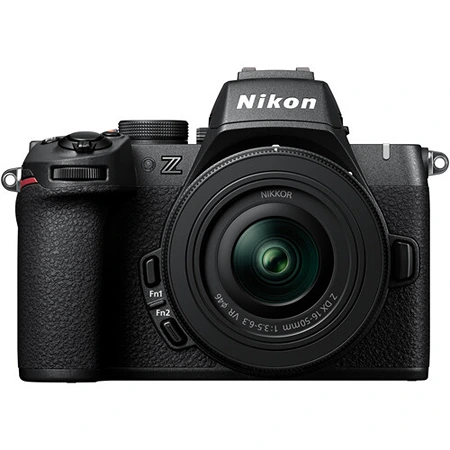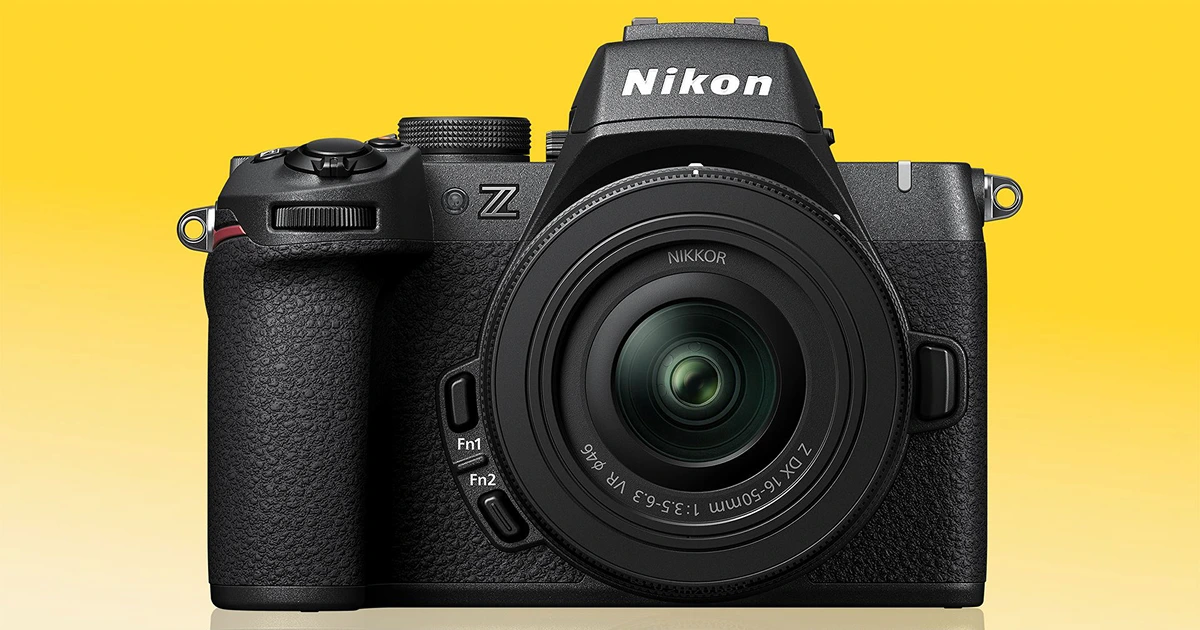
This camera combines advanced features, versatile performance, and compact design to deliver stunning photos and videos.
Buy on AmazonThe Nikon Z50 II builds upon Nikon’s first-ever crop-sensor mirrorless camera, arriving five years after the original Nikon Z50 launched in 2019. Designed to be smaller and lighter than Nikon’s full-frame Z-series cameras, the Z50 II features an APS-C (DX) sensor, making it compatible with Nikon’s range of compact DX lenses ideal for portability and everyday use.
While the Z50 II shares several core features with its predecessor—including the same reliable 20.9-megapixel sensor, a crisp 3.2-inch, 1.04 million-dot rear screen, and a clear 2.36 million-dot electronic viewfinder—it also retains the robust ISO range of 100-51,200 (expandable to 204,800) and a continuous shooting speed of 11fps using the mechanical shutter.
The most significant upgrade comes with the introduction of the latest Expeed 7 processor, the same powerhouse found in Nikon’s advanced full-frame cameras, from the Nikon Z f to the flagship Nikon Z9. This new chip significantly enhances autofocus accuracy and speed, delivers cleaner images at higher ISO settings compared to the original Z50, and boosts burst shooting capabilities to an impressive 30fps when using the electronic shutter. For photographers seeking a blend of compactness, versatility, and performance, the Nikon Z50 II is positioned to be a compelling choice.
Design & Handling
At first glance, the Z50 II closely resembles the original Z50, but it introduces several notable improvements. The body is slightly larger and features a deeper, more ergonomic grip for enhanced handling. The control layout has evolved to align more with higher-end models like the Nikon Z 6III, including the addition of a dedicated drive mode button. Unlike the Z50, which required users to navigate the menu to adjust drive settings, this new button streamlines the process. Physical zoom-in, zoom-out, and ‘Disp’ buttons have also been added, replacing the soft touchscreen controls previously found on the Z50.
Another standout feature is the dedicated Picture Control button, unique to the Z50 II and absent from all other Nikon cameras. This allows for quick access to in-camera JPEG processing presets. While those who shoot in Raw may find this less essential, the button—along with many other controls—can be reassigned to suit different functions, adding versatility to the camera’s operation.
The rear touchscreen retains the familiar 1.04 million-dot resolution, but now features a fully articulating vari-angle design. This allows the screen to flip out to the side and rotate freely, including facing forward for tasks like vlogging or self-recording. In comparison, the earlier Z50 was limited to tilting the screen up or down. While it could technically be positioned forward, the screen sat below the camera, often obstructed when mounted on a tripod.
The electronic viewfinder also carries over the 2.36 million-dot resolution from the previous model. However, it now offers double the brightness, significantly improving visibility and usability when shooting in bright lighting conditions.
Performance
The Z50 II is powered by Nikon’s latest-generation Expeed 7 processor, previously seen in flagship models such as the Z9, Z8, Z f, and Z6 III. This marks the first time the chip has been integrated into an APS-C body. The Expeed 7 processor brings advanced subject-detection autofocus capabilities, matching the intelligent tracking performance found in Nikon’s top-tier cameras. The autofocus system supports dedicated modes for people, animals, birds, vehicles, and airplanes, along with an auto mode capable of recognizing all these subjects simultaneously. Nikon confirms that the autofocus performance has not been limited, offering the same responsiveness and precision seen in higher-end models.
The maximum shooting speed with the mechanical shutter remains at 11 frames per second (fps), consistent with the previous generation. However, the Z50 II also introduces new ‘High-speed frame capture +’ modes that achieve 15fps and 30fps using an electronic shutter. While these faster modes are useful for capturing rapid action, they may introduce rolling shutter artifacts, causing slight image distortion with fast-moving subjects due to the scan rate of the electronic shutter. Additionally, these modes are restricted to JPEG or HEIC formats, which may limit post-processing flexibility compared to shooting in Raw.
The Z50 II also introduces a useful feature called Pre-release Capture, which allows the camera to start recording images before the shutter is fully pressed. When using this mode, the camera begins buffering images as soon as the shutter button is half-pressed, saving up to one second’s worth of frames leading up to the actual shot. It continues capturing until the shutter is fully released. This function is available exclusively with the High-speed frame capture + modes, meaning it is limited to JPEG or HEIC file formats without Raw support. While it is excellent for capturing fleeting moments, it can quickly consume memory card space and often results in a large number of near-identical frames, requiring additional time during the editing process.
Despite being positioned as an entry-level model, the Z50 II is particularly well-suited for action photography. It is a strong choice for those interested in sports or wildlife photography, especially when working within a budget. The 1.5x crop factor of the APS-C sensor provides additional reach compared to full-frame models, making it easier to fill the frame with distant subjects. Thanks to the new processor and autofocus system, the Z50 II even outperforms some older full-frame cameras, such as the Nikon Z5, Z 6II, and Z7 II, when it comes to consistently capturing fast-moving subjects.
The Z50 II has been designed with both photographers and videographers in mind, delivering impressive video capabilities. It records uncropped 4K video at 30 frames per second, oversampled from 5.6K for enhanced detail. A 4K 60p mode is also available for slow-motion footage, though it applies a 1.5x crop. For even slower motion, Full HD 120p recording is supported, enabling quarter-speed playback. Additionally, a 2x digital zoom can be applied without sacrificing image quality, and it offers 11 selectable zoom speeds for smooth, professional-looking transitions. Electronic video stabilization is available when shooting in Full HD, helping to reduce unwanted camera shake.
Advanced videographers will appreciate the inclusion of N-Log recording with a full 10-bit codec, allowing for significant flexibility in post-production color grading — comparable to the benefits of working with Raw images in still photography.
For content creators and vloggers, the Z50 II includes a Product Review mode, which automatically shifts focus from the presenter to objects brought close to the camera, making product demonstration videos seamless and polished. The camera is also automatically recognized as a webcam by computers and smartphones without the need for additional software, streamlining the workflow for live streaming and online meetings.
Other video-focused features include a headphone jack for real-time audio monitoring, which also serves as the connection point for the optional MC-DC3 remote cord, a dedicated accessory designed specifically for this model.
Final Verdict
Starting with some limitations, the Z50 II retains the same 20.9-megapixel sensor found in its predecessor. In comparison, competing models such as the Canon EOS R10, Fujifilm X-T30, and Sony A6400 offer higher resolutions of 24 megapixels or more. Additionally, in-body image stabilization (IBIS) is not present, though this feature is still relatively uncommon in APS-C cameras, especially at this price point. Models that do include IBIS, like the Sony A6700, typically come at a higher cost.
Despite these considerations, the Z50 II stands out as the most advanced camera in Nikon’s DX-format lineup. While it is positioned toward beginners and enthusiasts, its performance rivals that of higher-end Nikon models. The camera delivers professional-level features in a compact, lightweight body that remains easy to operate.
The Z50 II is a versatile tool suited to a wide range of photography styles. However, it is particularly well-suited for sports and wildlife photography, thanks to its responsive autofocus and advanced subject recognition, which are capable of tracking fast-moving subjects with precision. It also excels in video production, offering a variety of features that will appeal to filmmakers looking for high-quality results without breaking the budget.
